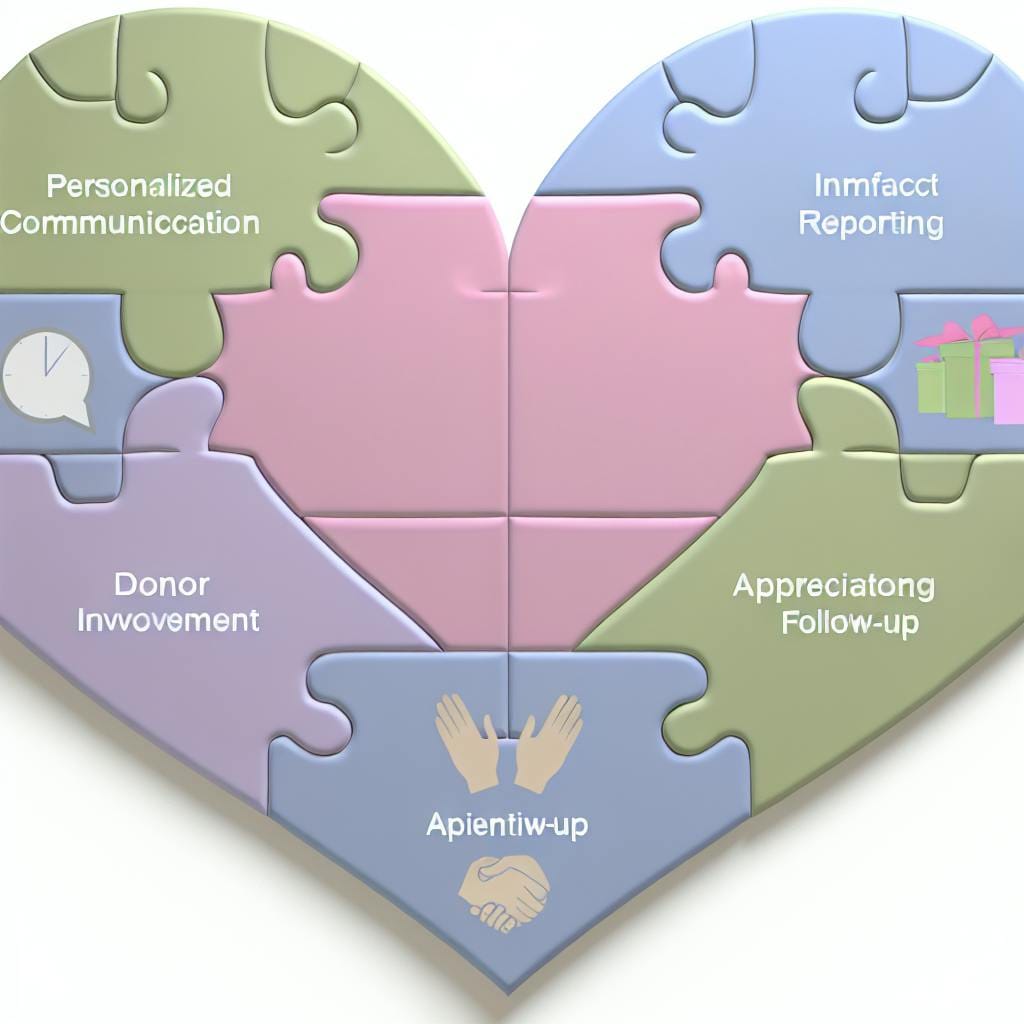6 Proven Ways to Build Lasting Donor Relationships
Learn how to build lasting donor relationships with personalized communication, clear impact reporting, donor involvement, timely appreciation, listening to donors, and regular follow-up. Boost donor retention and increase impact for nonprofits.

Here's a quick guide to building strong, long-term donor relationships for nonprofits:
- Personalized Communication
- Clear Impact Reporting
- Donor Involvement Opportunities
- Timely and Heartfelt Appreciation
- Listening and Feedback Collection
- Regular and Planned Follow-up
| Strategy | Key Benefit |
|---|---|
| Personalized Communication | Tailored messaging increases engagement |
| Clear Impact Reporting | Shows donors their contributions matter |
| Donor Involvement | Strengthens connection to the cause |
| Timely Appreciation | Encourages repeat donations |
| Listening to Donors | Improves donor satisfaction |
| Regular Follow-up | Maintains ongoing engagement |
These tactics help nonprofits boost donor retention, stabilize funding, and increase their impact. By focusing on these relationship-building strategies, organizations can create a loyal donor base and achieve their goals more effectively.
Related video from YouTube
1. Personalized Communication
Talking to donors in a personal way helps build strong relationships. Here's how to make your messages more personal:
1. Group your donors: Put donors into different groups based on how often they give, how much they give, and why they give. This helps you send messages that fit each group better.
2. Use donor information: Look at what you know about each donor to make your messages more personal. Use their name and mention their past gifts.
3. Change your content: Some donors might like pictures and graphs, while others prefer videos. Try different types of content for different groups.
4. Use the right way to reach out: Some donors like emails, others prefer phone calls or letters. Use the way each donor likes best.
5. Ask for the right amount: When asking for donations, suggest amounts based on what the donor has given before.
| What to do | Why it helps |
|---|---|
| Group donors | Messages fit better |
| Use donor info | Donors feel more connected |
| Change content | More donors pay attention |
| Use preferred contact method | Donors are more likely to respond |
| Ask for right amount | Donors more likely to give |
2. Clear Impact Reporting
Showing donors how their money is used and what it achieves helps build strong relationships. Here's how to report your impact clearly:
- Use numbers: Share specific data that shows your programs work. For example, tell how many people you helped or how things improved in your community.
- Tell stories: Along with numbers, share real stories about people your work has helped. This makes your impact easier to understand and remember.
-
Make detailed reports: Create yearly or quarterly reports that show what your organization has done. Include:
- How you spent money
- What your programs achieved
- Your future plans
-
Share information in different ways: Use various methods to tell donors about your impact:
- Your website
- Emails
- Social media
- Personal updates for big donors
- Ask donors what they think: Get feedback from donors about your reports. This helps you improve and shows donors you care about their opinions.
| What to Do | Why It Helps |
|---|---|
| Share specific numbers | Proves your work is effective |
| Tell personal stories | Makes your impact easier to understand |
| Create detailed reports | Gives a full picture of what you've done |
| Use different ways to share | Reaches donors through their preferred method |
| Get donor feedback | Improves your reports and shows you value donors' input |
3. Ways to Get Donors More Involved
Getting donors involved beyond just giving money helps build strong relationships. Here are some good ways to do this:
- Volunteer Work: Ask donors to help with hands-on tasks that support your cause. This could be cleaning up parks, helping at events, or using their job skills to help out.
- Speaking Up: Encourage donors to talk about your cause. They can share information on social media, contact local leaders, or gather signatures for petitions.
- Attending Events: Hold special events like dinners, fun runs, or auctions. These let donors meet your team and other supporters, creating good memories.
- Using Job Skills: Ask donors to use their work skills to help. They could offer free services or join groups where their knowledge can make a big difference.
- Online Help: Give donors ways to help from home. This could be online fundraising or digital volunteer work. It's good for busy people or those who live far away.
| Way to Help | What It Does |
|---|---|
| Volunteer Work | Lets donors see the cause up close |
| Speaking Up | Spreads the word about your work |
| Attending Events | Helps donors feel part of a team |
| Using Job Skills | Makes the most of donors' talents |
| Online Help | Makes it easy for anyone to join in |
By giving donors these different ways to help, you can:
- Make donors feel more connected to your work
- Show donors how much their help matters
- Build a group of supporters who really care about your cause
4. Timely and Heartfelt Appreciation
Saying "thank you" quickly and sincerely helps keep donors giving. Here's how to show donors you're grateful:
- Quick Thanks: Send a thank-you within 2 days of getting a gift. Donors who get quick thanks are 4 times more likely to give again.
-
Personal Touch: Use different ways to say thanks:
- Hand-written letters
- Personal video messages
- Phone calls from important people in your group
- Show Results: Tell donors how their money helps. This shows them their gift matters.
-
Public Thanks: Let others know about your donors:
- Put donor names on your website
- Thank donors at events and on social media
- Add big donors' names to a wall at your office
-
Special Treatment: Give donors special chances:
- Let them meet people they've helped
- Invite them to special online talks or events
- Show big donors around your workplace
| Way to Say Thanks | Why It Works |
|---|---|
| Quick Thank-You | Makes donors want to give again |
| Personal Messages | Makes donors feel close to your group |
| Showing Results | Proves their money helps |
| Public Thanks | Makes donors feel proud |
| Special Treatment | Gets donors more involved |
5. Listening to Donors and Getting Their Feedback
Listening to donors and getting their feedback helps build strong relationships. By asking for and using donor input, nonprofits can improve their work and make donors happier.
Here are good ways to listen and get feedback:
-
Ask donors what they think: Send out surveys to learn about:
- Why they support your group
- How they like to be contacted
- What they think about your work
- If they want to help more
-
Use what you learn: Change how you talk to donors based on what they tell you:
- Focus on what each donor cares about most
- Contact them in the way they like best
- Make changes: Show donors you care by making changes based on what they say.
-
Talk with donors: Give donors chances to ask questions and share ideas:
- Hold Q&A sessions
- Set up small group talks
- Let donors speak up at events
- Look at what donors say: Keep track of donor feedback and use it to make your work better.
| Way to Get Feedback | How It Helps |
|---|---|
| Surveys | Learn what donors like and want |
| One-on-one talks | Build closer ties and get detailed thoughts |
| Event feedback forms | Make future events better |
| Social media comments | Get quick input and talk with supporters |
| Donor advisory groups | Include donors in planning |
6. Regular and Planned Follow-up
Following up with donors regularly and in a planned way helps build strong relationships. Here's how to do it:
-
Group your donors: Talk to different types of donors in different ways. For example:
- Young donors: Send messages about how they're helping
- Big companies: Give detailed money reports
-
Use different ways to reach out:
- Emails for updates
- Social media for quick stories
- Letters for saying thanks
- Phone calls for personal chats
-
Set a schedule: Plan when to contact donors:
- Monthly news updates
- Updates on projects every three months
- Talks with donors twice a year
-
Make it personal:
- Use the donor's name
- Mention how much they gave
- Offer ways to help that match what they like
-
Ask what donors think:
- Find out how they want to hear from you
- Get ideas for your reports
- Tell them why you're asking for their thoughts
| Follow-up Method | How Often | What to Include |
|---|---|---|
| Email newsletter | Monthly | News, stories of impact |
| Project updates | Every 3 months | Progress, results, future plans |
| Feedback sessions | Twice a year | Ask for ideas, share goals |
| Thank-you letters | After each gift | Personal message, impact of donation |
| Social media posts | Weekly | Quick updates, volunteer opportunities |
Conclusion
Building strong donor relationships is key for nonprofits to succeed. By using the six methods in this article, you can create a solid base for keeping donors engaged and supportive.
Here's a quick look at the six ways to build lasting donor relationships:
| Method | Main Benefit |
|---|---|
| Personal messages | Donors feel more connected |
| Clear impact reports | Donors see how they help |
| Ways to get involved | Donors feel part of the team |
| Quick, sincere thanks | Donors feel appreciated |
| Listening to donors | Donors know you care about their ideas |
| Regular follow-ups | Donors stay interested in your work |
These methods help nonprofits:
- Keep more donors
- Get more donations
- Build a community of supporters
Remember, donor relationships are like friendships – they need time and care to grow. As you use these methods, you'll likely see:
- More donors staying with you
- Donors giving more
- More supporters talking about your cause
By focusing on building these relationships, your nonprofit will be better able to:
- Do its main work
- Help more people
- Make bigger changes in your community
Putting time into these relationship-building methods will help your nonprofit now and in the future. As you make your donor relationships stronger, you'll be able to do more good work and make a bigger difference.
FAQs
How do you maintain donor relationships?
To keep good relationships with donors:
| Action | Description |
|---|---|
| Update often | Tell donors about your work and results |
| Make it personal | Use donors' names and mention their gifts |
| Say thanks quickly | Send a thank-you soon after each gift |
| Offer ways to help | Ask donors to join events or volunteer |
| Ask for thoughts | Get donors' ideas to make your work better |
How do you communicate effectively with donors?
To talk well with donors:
1. Group donors: Send different messages to different types of donors
2. Share stories: Tell how donations help real people
3. Be clear: Explain how you use donations
4. Use many ways to reach out: Send emails, use social media, and talk in person
5. Show thanks: Say "thank you" often, not just when you get money
| Communication Method | Why It Works |
|---|---|
| Group donors | Messages fit better |
| Share stories | Shows how gifts help |
| Be clear | Builds trust |
| Use many ways to reach out | Reaches more donors |
| Show thanks | Makes donors feel good |

